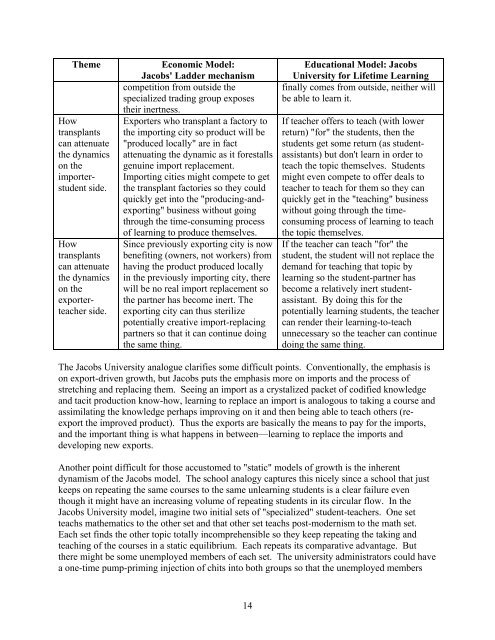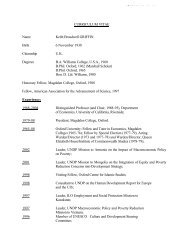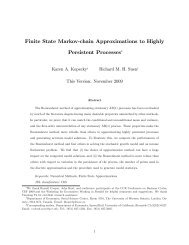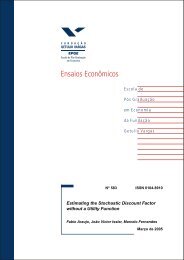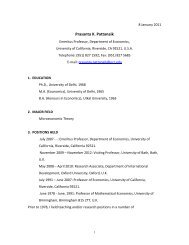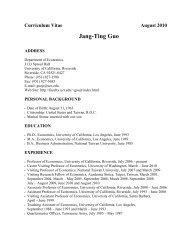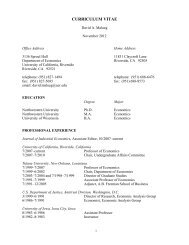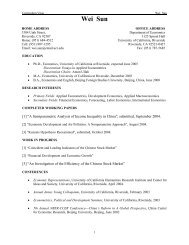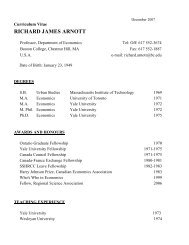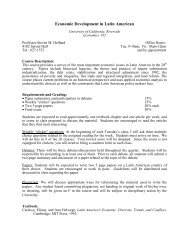Jane Jacobs on Diversification and Specialization - Economics
Jane Jacobs on Diversification and Specialization - Economics
Jane Jacobs on Diversification and Specialization - Economics
You also want an ePaper? Increase the reach of your titles
YUMPU automatically turns print PDFs into web optimized ePapers that Google loves.
Theme<br />
How<br />
transplants<br />
can attenuate<br />
the dynamics<br />
<strong>on</strong> the<br />
importerstudent<br />
side.<br />
How<br />
transplants<br />
can attenuate<br />
the dynamics<br />
<strong>on</strong> the<br />
exporterteacher<br />
side.<br />
Ec<strong>on</strong>omic Model:<br />
<str<strong>on</strong>g>Jacobs</str<strong>on</strong>g>' Ladder mechanism<br />
competiti<strong>on</strong> from outside the<br />
specialized trading group exposes<br />
their inertness.<br />
Exporters who transplant a factory to<br />
the importing city so product will be<br />
"produced locally" are in fact<br />
attenuating the dynamic as it forestalls<br />
genuine import replacement.<br />
Importing cities might compete to get<br />
the transplant factories so they could<br />
quickly get into the "producing-<strong>and</strong>exporting"<br />
business without going<br />
through the time-c<strong>on</strong>suming process<br />
of learning to produce themselves.<br />
Since previously exporting city is now<br />
benefiting (owners, not workers) from<br />
having the product produced locally<br />
in the previously importing city, there<br />
will be no real import replacement so<br />
the partner has become inert. The<br />
exporting city can thus sterilize<br />
potentially creative import-replacing<br />
partners so that it can c<strong>on</strong>tinue doing<br />
the same thing.<br />
Educati<strong>on</strong>al Model: <str<strong>on</strong>g>Jacobs</str<strong>on</strong>g><br />
University for Lifetime Learning<br />
finally comes from outside, neither will<br />
be able to learn it.<br />
If teacher offers to teach (with lower<br />
return) "for" the students, then the<br />
students get some return (as studentassistants)<br />
but d<strong>on</strong>'t learn in order to<br />
teach the topic themselves. Students<br />
might even compete to offer deals to<br />
teacher to teach for them so they can<br />
quickly get in the "teaching" business<br />
without going through the timec<strong>on</strong>suming<br />
process of learning to teach<br />
the topic themselves.<br />
If the teacher can teach "for" the<br />
student, the student will not replace the<br />
dem<strong>and</strong> for teaching that topic by<br />
learning so the student-partner has<br />
become a relatively inert studentassistant.<br />
By doing this for the<br />
potentially learning students, the teacher<br />
can render their learning-to-teach<br />
unnecessary so the teacher can c<strong>on</strong>tinue<br />
doing the same thing.<br />
The <str<strong>on</strong>g>Jacobs</str<strong>on</strong>g> University analogue clarifies some difficult points. C<strong>on</strong>venti<strong>on</strong>ally, the emphasis is<br />
<strong>on</strong> export-driven growth, but <str<strong>on</strong>g>Jacobs</str<strong>on</strong>g> puts the emphasis more <strong>on</strong> imports <strong>and</strong> the process of<br />
stretching <strong>and</strong> replacing them. Seeing an import as a crystalized packet of codified knowledge<br />
<strong>and</strong> tacit producti<strong>on</strong> know-how, learning to replace an import is analogous to taking a course <strong>and</strong><br />
assimilating the knowledge perhaps improving <strong>on</strong> it <strong>and</strong> then being able to teach others (reexport<br />
the improved product). Thus the exports are basically the means to pay for the imports,<br />
<strong>and</strong> the important thing is what happens in between—learning to replace the imports <strong>and</strong><br />
developing new exports.<br />
Another point difficult for those accustomed to "static" models of growth is the inherent<br />
dynamism of the <str<strong>on</strong>g>Jacobs</str<strong>on</strong>g> model. The school analogy captures this nicely since a school that just<br />
keeps <strong>on</strong> repeating the same courses to the same unlearning students is a clear failure even<br />
though it might have an increasing volume of repeating students in its circular flow. In the<br />
<str<strong>on</strong>g>Jacobs</str<strong>on</strong>g> University model, imagine two initial sets of "specialized" student-teachers. One set<br />
teachs mathematics to the other set <strong>and</strong> that other set teachs post-modernism to the math set.<br />
Each set finds the other topic totally incomprehensible so they keep repeating the taking <strong>and</strong><br />
teaching of the courses in a static equilibrium. Each repeats its comparative advantage. But<br />
there might be some unemployed members of each set. The university administrators could have<br />
a <strong>on</strong>e-time pump-priming injecti<strong>on</strong> of chits into both groups so that the unemployed members<br />
14


